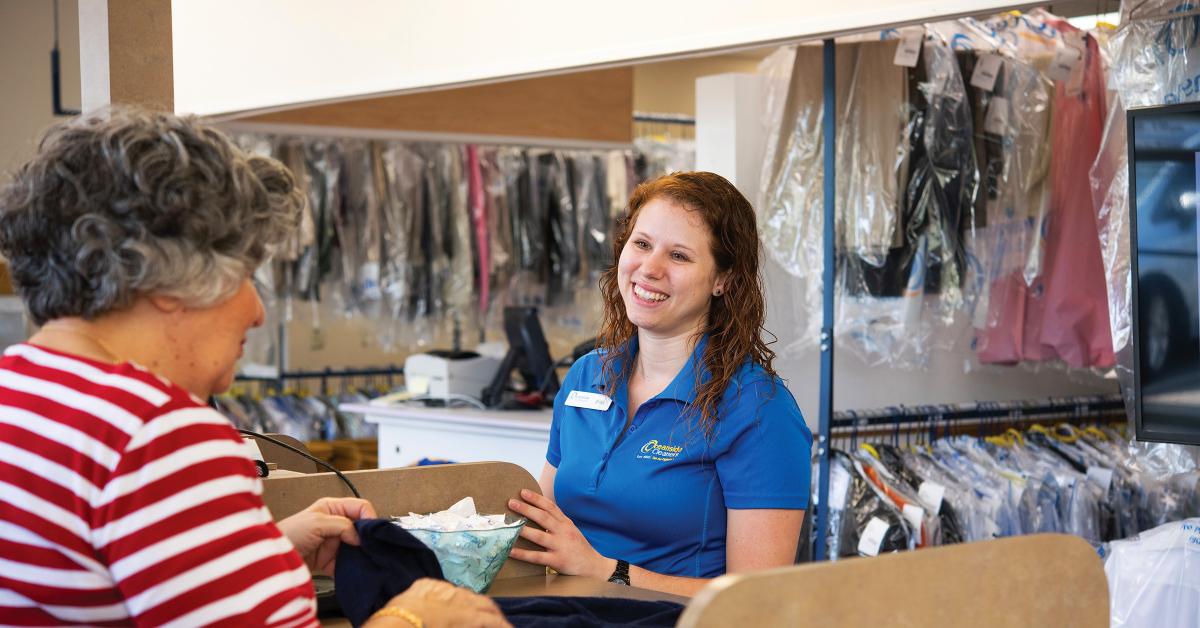CHICAGO — The ability to stay at the top of customers’ minds is key to long-lasting, dependable business. By providing outstanding customer service, dry cleaners can maintain client loyalty and keep them coming back.
In Part 1 of this series on pleasantly surprising your customers, we examined the mindset of cleaners who provide great customer service. In Part 2, we looked at the role of training staff in cleaners’ quests to keep their customers happy. In Part 3, we explored ways to gauge the experience through their customers’ eyes, and what to do when that experience falls short. Today, we’ll conclude by asking for the secrets of cleaners who have found great ways to please their clients.
Secrets of Success
While every business is unique, learning from those who are successful in reaching their customer service goals can provide valuable insight.
“We’ve taken a bit of an unconventional approach by limiting the services that we offer,” says David Crouse, owner of Crouse’s Cleaners in Grande Prairie, Alberta, Canada. “Many dry cleaners try to offer as much as they can for the additional revenue, but one of the business practices that we’ve taken is that we have our five main services, and we try not to go outside of that. That’s allowed us to streamline operations and make consistent systems around those services. Consistency is what’s going to lead to driving that long-term consumer behavior. It removes the question entirely of them needing to go elsewhere.”
Being thought of in a different light from other dry cleaners will build customer loyalty, says Kyle Matthews, director of operations for Janet Davis Cleaners in Detroit.
“If you treat every interaction as a transaction, then your customers will treat you as a commodity,” he says. “You need to think about everything as a relationship-building opportunity. Teach people to interact with customers the same way they would build a relationship with someone. You don’t make it all about yourself — you figure out what their needs are, and you work to learn about them. By working to build that relationship instead of treating everything as a transaction, it changes your mindset.”
David Meyer, owner of Elite Cleaners in Phoenix, Arizona, knows that the most valuable asset he has is his team. Making sure they know they are important to their leader makes providing great customer service much easier.
“My store is 23 years old, and there’s only one piece of equipment that’s over 3 years old — that’s the drycleaning machine, and it’s being changed in the next few weeks,” he says. “I could have had a fancier car, a nicer house and this and that. But it goes back to how I treat my staff. I want them to have the best equipment possible. I don’t expect them to give me the best product when they have a machine that’s not working correctly.”
A recent experience allowed Meyer to test this mindset: “I had a manager challenge me about bringing in a mechanic to fix one press. It wasn’t working properly, and I didn’t want the worker to struggle. I’d rather have a mechanic come in, do 10 minutes of work and be paid for an hour, and make sure that lady feels happy.”
Final Thoughts
For Michael Harris, owner of Oceanside Cleaners in Jacksonville, Florida, the secret to providing outstanding service can be distilled into one word: empathy.
“Be a good listener and have patience,” he says. “You never know what they’re going through. When they come in and they chew you out over that broken button? You don’t know what’s going on in their lives. Maybe they’ve lost a wife. Maybe they’ve lost a mom. Maybe their dog is sick. Maybe they’re sick. You just never know what people are facing at that moment.”
Rita Foley, owner of Regency Dry Cleaners and White Star Laundry in Durham, North Carolina, says that this quality figures into her company’s training as well. Customers can also give you great ideas on how to serve them better.
“It starts with listening to your customers and putting the methods in place to obtain their feedback,” she says. “Once you’ve listened, learn from this. Let your customers know you are putting their feedback to use with specific examples of actions you are taking — use it for a marketing campaign!”
Foley cites an example of a change she made that was simple but added to the customer experience: “We made the shift from twist ties to rubber bands to group hangers together for easier transport based upon an observation and comment from a customer. The key, again, is to actually do something about their feedback and make the needed improvements and advancements.”
Learning from your own experience dealing with businesses — both good and bad — can generate ideas if you are open to them.
“I’m always frustrated when I’m dealing with a business that’s slow, and I’m always trying to ask, ‘How is my business making it hard for people to give me money?’” says Monika Manter, co-owner of Balfurd Dry Cleaners in State College, Pennsylvania.
She and her team take their experiences and see if they can apply those lessons to Balfurd.
“Look at where you’re creating friction in your business,” she says. “Is there only one way to contact you? Is it a phone call? Can your clients only sign up for delivery service by talking to one person, and then they have to wait for a callback? It’s looking at those little things that frustrate the heck out of people. Speed is so key in the customer experience.”
For Part 1 of this series, click HERE. For Part 2, click HERE. For Part 3, click HERE.
Have a question or comment? E-mail our editor Dave Davis at [email protected].

